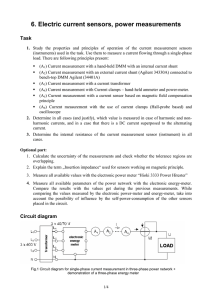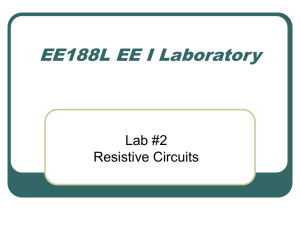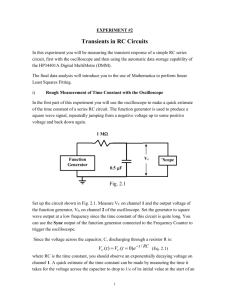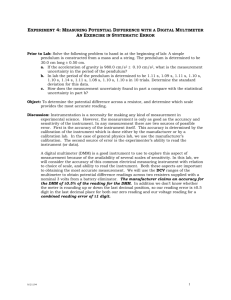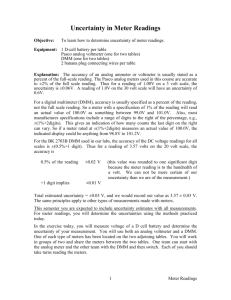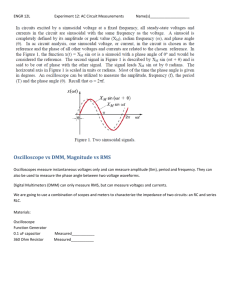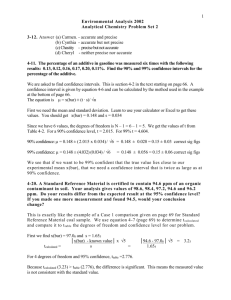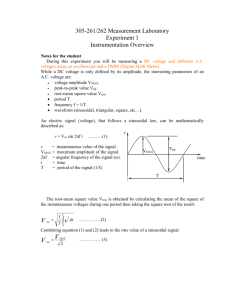Power measurement at line frequency with highest precision
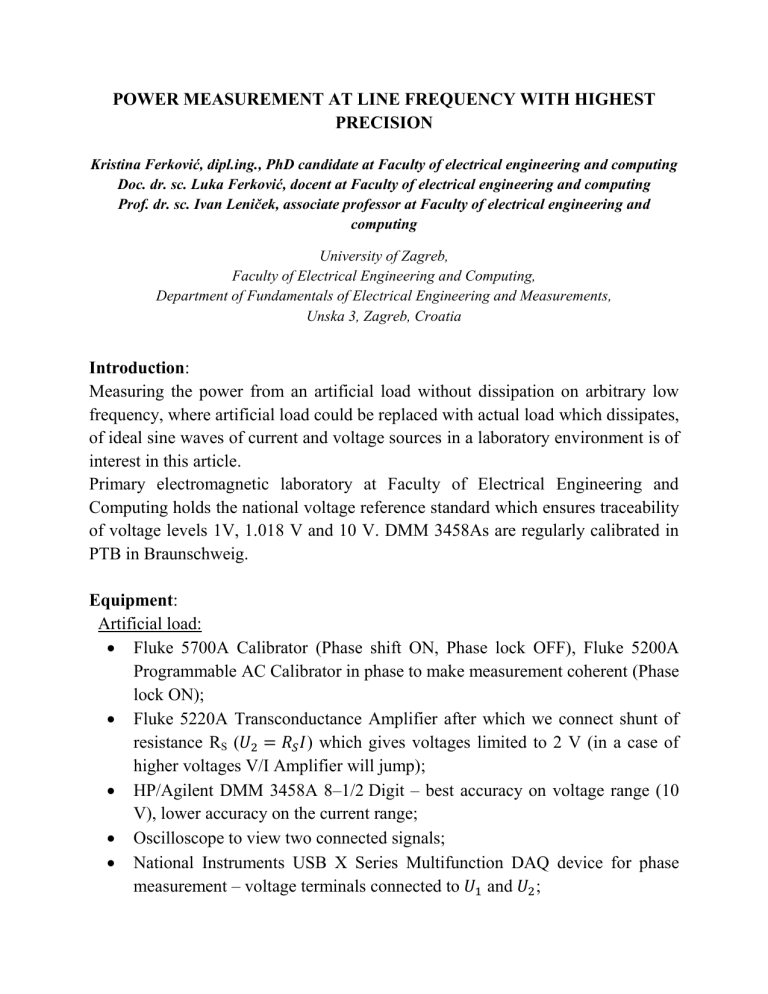
POWER MEASUREMENT AT LINE FREQUENCY WITH HIGHEST
PRECISION
Kristina Ferković, dipl.ing., PhD candidate at Faculty of electrical engineering and computing
Doc. dr. sc. Luka Ferković, docent at Faculty of electrical engineering and computing
Prof. dr. sc. Ivan Leniček, associate professor at Faculty of electrical engineering and computing
University of Zagreb,
Faculty of Electrical Engineering and Computing,
Department of Fundamentals of Electrical Engineering and Measurements,
Unska 3, Zagreb, Croatia
Introduction :
Measuring the power from an artificial load without dissipation on arbitrary low frequency, where artificial load could be replaced with actual load which dissipates, of ideal sine waves of current and voltage sources in a laboratory environment is of interest in this article.
Primary electromagnetic laboratory at Faculty of Electrical Engineering and
Computing holds the national voltage reference standard which ensures traceability of voltage levels 1V, 1.018 V and 10 V. DMM 3458As are regularly calibrated in
PTB in Braunschweig.
Equipment :
Artificial load:
Fluke 5700A Calibrator (Phase shift ON, Phase lock OFF), Fluke 5200A
Programmable AC Calibrator in phase to make measurement coherent (Phase lock ON);
Fluke 5220A Transconductance Amplifier after which we connect shunt of resistance R
S
( 𝑈
2
= 𝑅
𝑆
𝐼 ) which gives voltages limited to 2 V (in a case of higher voltages V/I Amplifier will jump);
HP/Agilent DMM 3458A 8–1/2 Digit – best accuracy on voltage range (10
V), lower accuracy on the current range;
Oscilloscope to view two connected signals;
National Instruments USB X Series Multifunction DAQ device for phase measurement – voltage terminals connected to 𝑈
1
and 𝑈
2
;
Current source (from 10 mA to 20 A);
Voltage source (from 10 mV to 1000 V);
VD – voltage divider without phase shift (for higher input voltages – from
100 V);
AC shunt – nominal values of 100 mA, 1 A and 20 A – FLUKE A40;
Swerlein’s algorithm on PC developed in LabVIEW software which measures True RMS of AC voltages on DC range (improved accuracy);
L–COM IEEE–488 GPIB Cable; GPIB–USB–HS;
Laboratory environment (temperature: 23 °C, humidity: 50 % RH);
Actual load:
The settled system can be connected to the actual load.
Measurement procedure :
Figure. Block diagram of digital power meter
Equations :
𝑃 = 𝑈𝐼𝑐𝑜𝑠𝜑 = 𝑈
1
∙
𝑈
2 ∙ 𝑐𝑜𝑠𝜑 (1)
𝑅
𝑆
Type A evaluation of measurement uncertainty is not of concern in this article.
It is calculated from the statistical distribution of the quantity values from a series of measurements of various types of measurement conditions, such as repeatability, intermediate precision and reproducibility, and can be characterized by standard deviations.
Type B evaluation of measurement uncertainty is associated with authoritative published quantity values of a certified reference material, obtained from a calibration certificate and the accuracy class of a verified measuring instrument: 𝑢
𝑃
𝜕𝑃
= √(
𝜕𝑈
1
∙ 𝑢
𝑈
1
)
2
𝜕𝑃
+ (
𝜕𝑈
2 𝒖
𝑷
=
∙ 𝑢
𝑈
2
)
2
𝜕𝑃
+ (
𝜕𝑅
𝑆
∙ 𝑢
𝑅 𝑠
𝜕𝑃
) + (
𝜕𝑐𝑜𝑠𝜑
∙ 𝑢 𝑐𝑜𝑠𝜑
)
2
(2)
√(
𝑼
𝟐
𝑹
𝑺
∙ 𝒄𝒐𝒔𝝋 ∙ 𝒖
𝑼
𝟏
)
𝟐
+ (
𝑼
𝟏
𝑹
𝑺
∙ 𝒄𝒐𝒔𝝋 ∙ 𝒖
𝑼
𝟐
)
𝟐
+ (−
𝑼
𝟏
𝑼
𝟐 𝒄𝒐𝒔𝝋
𝑹
𝟐
𝑺
∙ 𝒖
𝑹
𝑺
)
𝟐
+ (𝑼
𝟏
∙
𝑼
𝟐
𝑹
𝑺
∙ 𝒖 𝒄𝒐𝒔𝝋
)
𝟐
(3) 𝑢
𝑃 𝑟
= 𝑢
𝑃
𝑃
= √𝑢
𝑈
1𝑟
2 + 𝑢
𝑈
2𝑟
2 + 𝑢
𝑅
𝑆𝑟
2 + 𝑢 𝑐𝑜𝑠𝜑 𝑟
2 (4)
Measurement uncertainty Type B of DMM 3458A 𝑈
1 and 𝑈
2
:
For industry frequency (50 Hz) Swerlein’s algorithm [1] which calculates AC
RMS value of a measured voltage on DMM’s DC range [2] has a minimum uncertainty of 13 ppm at line frequency. 𝑢
𝑈
1𝑟
≅ 20 ppm, 𝑢
𝑈
2𝑟
≅ 20 ppm.
Measurement uncertainty Type B of a shunt 𝑅
𝑆
:
Maximum AC–DC difference up to 1 kHz for a shunt nominal current of 100 mA is 14 ppm [3]. This value should be added DC absolute accuracy of 5 ppm. 𝑢
𝑅
𝑆𝑟
≅ 20 𝑝𝑝𝑚.
Measurement uncertainty Type B of a power factor cos 𝜑 :
This value increases with angle. The uncertainty is the lowest for 0 ° and highest for ± 90 ° (inductive or capacitive load). Here is calculation of a relative error for 0° and 75°: 𝑢 𝜑
= ±2 𝑚° → { 𝑢 𝑢 𝑐𝑜𝑠𝜑 𝑟 𝑐𝑜𝑠𝜑 𝑟
(𝜑 = 0°) = 6 ∙ 10 −10
(𝜑 = 75°) = 130 𝑝𝑝𝑚
.
Table presents values of shunt resistances depending on nominal currents which flow through it:
Table. Resistance values of different shunts
Shunt I n
U R
S
A40B
A40B
100 mA
1 A
0,8 V
0,8 V
8 Ω
0,8 Ω
A40 20 A 448 mV
22,4 mΩ
Calibration:
Traceability [4] of HP/Agilent DMM 3458A instruments is confirmed by document in reference [2]. DMM has calibrated voltage divider embedded in it. AC/DC shunts are calibrated without parasitic impedances. Parasitic impedances occur during measurements at higher frequencies.
Synchronization:
Triggering of both DMM 3458A instruments should be synchronized by software development (LabVIEW VI). Measurement of a phase can be done afterwards.
Conclusions:
This system can measure power with measurement uncertainty within 200 ppm.
Power measurement in this system shows that the most measurement uncertainty is inserted by measurement of power factor. Maximum power which can be measured is 20 kW.
References
1.
R. L. Swerlein – A 10 ppm accurate digital AC measurement algorithm – in Proc. NCSL
Workshop Symp.
– pp. 17–36 – 1991.
2.
Agilent Technologies 3458A Multimeter, „User's guide “
, Agilent Technologies , Manual Part
Number: 03458-90014.
3.
FLUKE, A40B Series Precision Current Shunts, Precision, low inductance shunts for dc and ac current metrology , Technical Data.
4.
BIPM JCGM 200:2012 International vocabulary of metrology – Basic and general concepts and associated terms (VIM) – 3rd edition – 2008 version with minor corrections.
